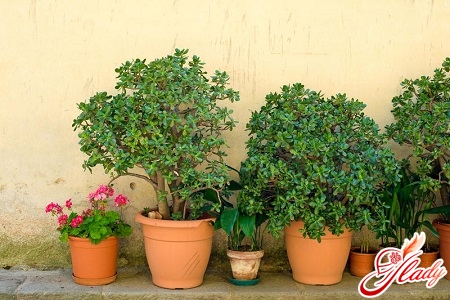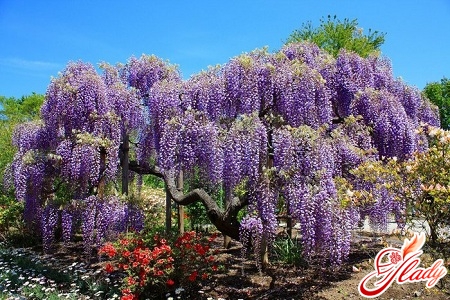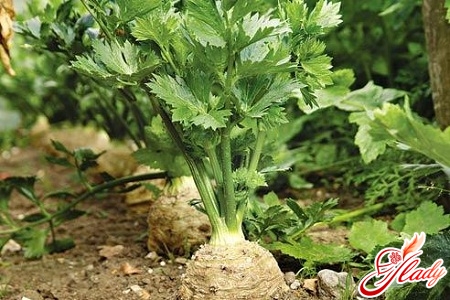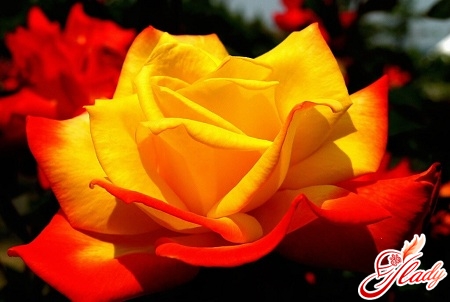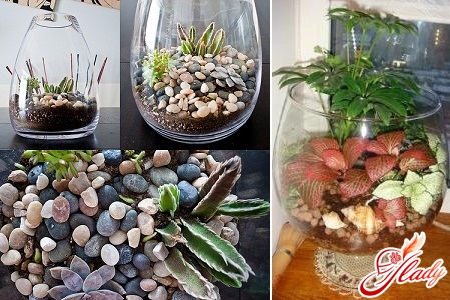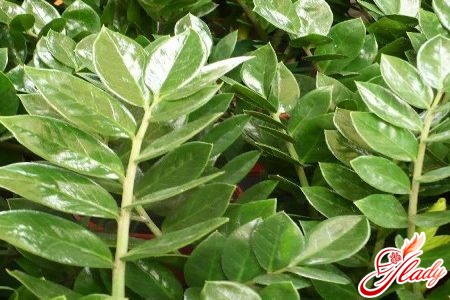 In recent years, it has become very popularAn interesting indoor flower is the zamioculcas, also known as the dollar tree and women's happiness. Note that there are other indoor plants with similar popular names. For example, the money tree is called the fat woman, and the name women's happiness has long been firmly established for the indoor flower spathiphyllum. However, the zamioculcas stands apart from the usual and even exotic indoor favorites. It grows very slowly, looks more than noble, and does not require any specific care. This plant is closely associated with the eastern teaching of Feng Shui, according to which it is able to increase the owner's savings. Many believe that this indoor flower is poisonous, someone is trying to find out whether the zamioculcas blooms at all, and someone associates all sorts of signs with this flower. In a word, not a flower, but a riddle. So let's try to solve this riddle.
In recent years, it has become very popularAn interesting indoor flower is the zamioculcas, also known as the dollar tree and women's happiness. Note that there are other indoor plants with similar popular names. For example, the money tree is called the fat woman, and the name women's happiness has long been firmly established for the indoor flower spathiphyllum. However, the zamioculcas stands apart from the usual and even exotic indoor favorites. It grows very slowly, looks more than noble, and does not require any specific care. This plant is closely associated with the eastern teaching of Feng Shui, according to which it is able to increase the owner's savings. Many believe that this indoor flower is poisonous, someone is trying to find out whether the zamioculcas blooms at all, and someone associates all sorts of signs with this flower. In a word, not a flower, but a riddle. So let's try to solve this riddle.
Zamiokulkas as such
People affectionately call him "zamik".This exotic plant itself belongs to the Araceae family, which includes shrubs, vines, and herbs. Araceae can live in water (like algae) or in swamps, and can do without soil, settling on trees, or grow in the driest places. And although most representatives of this amazing family prefer a tropical climate, there are also species that easily survive subarctic winters. However, our domestic Zamioculcas belongs to the drought-resistant Araceae species and has the botanical name Zamioculcas zamiifolia, which in Latin sounds like Zamioculcas zamiifolia. By the way, another name for this species is the Zanzibar gem. And Zamioculcas zamiifolia owes this name to its homeland - the rocky plateau of Zanzibar. Zamioculcas, which migrated from Africa to our homes, is a succulent. What we see above the soil surface in a flowerpot are just leaves. And the tuberous stem of this amazing plant is almost completely hidden in the ground. So, zamioculcas owes its exotic appearance and fleshy, dissected leaves covered with a waxy coating only to its natural habitat. Zamioculcas, like all succulents, has significantly thickened leaves and leaf petioles. In nature, this is necessary for the accumulation and conservation of moisture. And the waxy coating on the leaves reduces its evaporation and protects the plant from sunburn. Zamioculcas flowers are very unique and do not look like flowers in the usual sense for us. The inflorescence of this plant consists of a large pale cob and a light green cover. Such nondescriptness of the flower is explained, again, by its natural habitat and the established method of pollination - pollen is carried only by the wind and a few crawling insects. Zamioculcas was included in botanical catalogues at the beginning of the nineteenth century under the name Caladium zamiifolium. It received its modern botanical name only ninety years later, and it was not until the end of the twentieth century that it was grown indoors. At first, Zamioculcas replenished the collections of professional flower growers, and then became popular among amateurs. Today, this exotic flower is experiencing the peak of its popularity. It has not yet lost its appeal as a rare exotic plant, but has already become a fashionable indoor flower and decoration of any fashionable interior.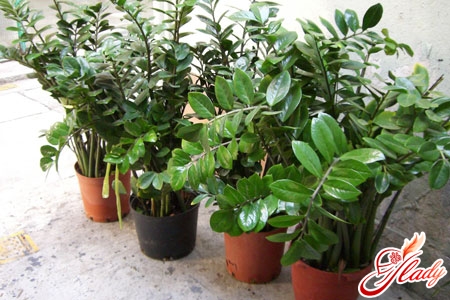
Zamiokulkas as a talisman
Apart from its obvious decorative value, thisThe flower also has a symbolic value. For example, it is popularly known as women's happiness. Of course, one can argue and object that women's happiness is a completely different flower, but no. As rumor has it, zamioculcas is really capable of magically influencing women's happiness. But! Firstly, for this to happen, it must be given as a gift, not bought. Secondly, the miraculous properties of this plant awaken only during the flowering period. But getting zamioculcas to bloom is very, very difficult! But if you believe in signs, then as soon as the zamioculcas you were given blooms, happiness will immediately knock on your door. And not just happiness, but women's happiness. By the way, one of the versions of the origin of the name women's happiness is the very unusual appearance of the zamioculcas flowers themselves. The fact is that the flower of this houseplant vaguely resembles a spathiphyllum flower, firstly, and secondly, it has an ambiguous similarity with the main male dignity. In general, with enough imagination, you can see phallic symbolism in the zamioculcas flower: in fact, this impressively sized ear of corn evokes certain associations. So decide for yourself whether this unusual name, promising happiness to all its owners, was given to this flower in jest or in earnest, intentionally or by mistake. But there should be no doubt about the other popular name of the plant. But only if you believe in omens and follow the eastern teachings of feng shui. The fact is that, according to the teachings of feng shui, zamioculcas is able to attract money to the house, like another talisman flower - the fat woman (money tree). But to awaken the financial magnetism of the fat woman, according to the rules of feng shui, you need to bury coins in a pot with a plant, and the dollar tree is easy enough to settle in your home. According to the rules of feng shui, all talismans must be placed in the corresponding "thematic" zones. So, a pot with zamioculcas should be placed in the Wealth sector, which is located in the south-eastern part of the house or a separate room. By the way, all zones of influence in your home can be determined using the Bagua grid - a special Feng Shui tool. It is possible that the dollar tree got its name not only as a wealth talisman in Feng Shui, but simply because of the appearance of its dark green rounded leaves. Perhaps because this initially very expensive and rare plant could only be found in rich houses, whose wealthy owners, of course, had overseas money. Agree that the concepts of Feng Shui and dollars are practically not related to each other. Nevertheless, this Feng Shui money talisman was named the dollar tree. However, we will leave the solution to this issue to the experts. It is enough for us that Zamioculcas is recognized as a Feng Shui talisman for attracting wealth, and has also become a kind of talisman of female happiness. In a word, this flower not only looks fashionable and trendy, but also brings its owner faith in luck, wealth and happiness to ladies who believe in omens.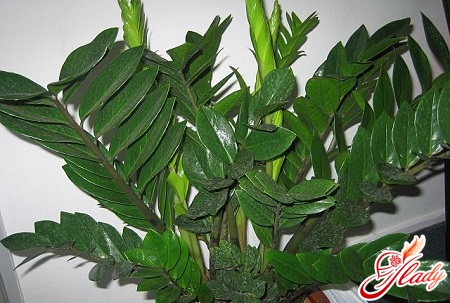
Features of zamiokulkasa
The flower is, although unpretentious, it causesмножество вопросов. Например, вопрос о том, ядовит замиокулькас или нет, интересует практически всех цветоводов-любителей, так как профессионалам известно, что любой представитель ароидных ядовит в той или иной степени. Так вот, замиокулькас ядовит. Но не пугайтесь и не паникуйте: ядовит он не смертельно и относится к числу условно опасных растений. Этот комнатный цветок не принесет вам ощутимого вреда. Ядовит не весь цветок, а только его листья, но самый большой вред, который он может нанести человеку – это аллергическая реакция. Поэтому, зная о подобной особенности своего организма, работайте с замиокулькасом в перчатках. Условно опасен он и для домашних животных. Если ваша птичка или киска попробует этот комнатный цветок на вкус, то не исключена та же аллергическая реакция или кишечное расстройство. Так что просто держите его в недоступных для детей и животных местах. Это комнатное растение очень неприхотливо, но имеет свои особенности. Так, например, оно засухоустойчиво, но любит периодические опрыскивания и обмывания листьев. Зимой замиокулькас прекрасно чувствует себя в помещении, а летом ему лучше на свежем воздухе. Все дело в том, что замиокулькас растет очень медленно, зимой находится в состоянии покоя, а в вегетативный период (теплое время года) его рост усиливается под воздействием влаги, тепла и света. Зимой замиокулькас поливают редко, не опрыскивают и ни в коем случае не пересаживают. Все манипуляции с растением проводят только весенне-летний период, а зимой его необходимо только поливать. Однако в квартирах воздух зимой становится очень сухим из-за отопительный приборов. Поэтому даже у такого засухоустойчивого растения как замиокулькас могут начать желтеть кончики листьев. В этом случае необходимо повысить влажность в помещении, а цветок опрыскивать, стараясь увлажнять не столько его листья, сколько воздух вокруг растения. Новые ростки в это время года замиокулькас не дает, а вот его листья продолжают расти, но настолько медленно, что это практически незаметно. И что интересно, старые листья растут лучше, если горшок замиокулькасу тесен, а вот новые ростки он дает после перевалки в более просторный горшок, где обновлена почва, или после деления куста. Вообще своевременная перевалка растения всегда дает хороший результат: замиокулькас и растет лучше, и болеет меньше. Только после перевалки земля обязательно должна полностью покрывать клубень и кони растения. Хотя у замиокулькаса болезни возникают нечасто, он тоже может занедужить при неправильном уходе. Например, от избытка влаги у него чернеют листья, поэтому переувлажнять грунт в горшке категорически нельзя, а воду из поддона обязательно нужно сливать. Чернеют листья и после переохлаждения растения. В этих случаях лучше всего пересадить цветок и полностью обновить грунт, так как старая земля может быть заражена гнилостными бактериями. Плохо влияет на рост замиокулькаса и истощенная почва, поэтому удобрять цветок тоже необходимо любыми комплексными удобрениями. Для выращивания замиокулькаса не требуется специальный грунт, а вполне подойдет обычная дерновая земля, а еще лучше – почвосмесь, в которую входит песок, листовая и дерновая земля в равных пропорциях. При поливе цветка необходимо ориентироваться на то, в каком состоянии находится грунт. Между очередными поливами земля в горшке должна хорошо просыхать, так как недостаток влаги замиокулькас переносит гораздо легче, чем ее избыток. Так что для успешного выращивания замиокулькаса нужно только создать ему близкие к природным условия – тепло, хорошее освещение и умеренный полив. Согласитесь, что сделать это очень и очень просто. Будьте внимательны к своему любимцу, и не задавайтесь вопросом, почему замиокулькас у вас не растёт. Он растет, только очень медленно. Зато живет долго и хлопот особых не доставляет. Вот почему многие предпочитают приобретать уже взрослое растение. Впрочем, истинных любителей и ценителей медленный рост не смущает. Процесс выращивания этого экзота приносит не меньше удовольствия, чем разведение многих других комнатных цветов. Советуем почитать:





